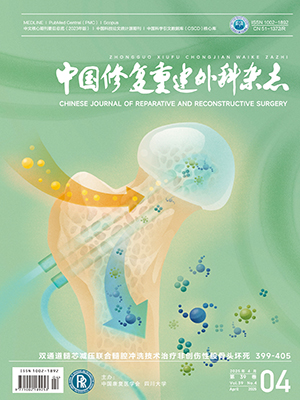| 1. |
Ünal MB, Cansu E, Parmaksizoğlu F, et al. Treatment of osteonecrosis of the femoral head with free vascularized fibular grafting: results of 7.6-year follow-up. Acta Orthop Traumatol Turc, 2016, 50(5): 501-506.
|
| 2. |
Mont MA, Cherian JJ, Sierra RJ, et al. Nontraumatic osteonecrosis of the femoral head: Where do we stand today? A ten-year update J Bone Joint Surg (Am), 2015, 97(19): 1604-1627.
|
| 3. |
赵德伟, 谢辉. 成人股骨头坏死保髋手术治疗的策略及探讨. 中国修复重建外科杂志, 2018, 32(7): 792-797.
|
| 4. |
肖凯, 罗殿中, 程徽, 等. 股骨颈基底部旋转截骨术治疗早期股骨头坏死的临床疗效. 中华骨科杂志, 2018, 38(7): 425-432.
|
| 5. |
唐立群. 髋关节外科脱位技术在髋关节手术的临床应用效果及对髋关节功能、预后的影响. 中国实用医药, 2019, 14(1): 17-19.
|
| 6. |
姚晨, 沈计荣, 杜斌, 等. 髋关节外科脱位死骨清理打压植骨治疗 ⅢA、ⅢB 期股骨头无菌性坏死. 中华解剖与临床杂志, 2016, 21(2): 133-136.
|
| 7. |
Gautier E, Ganz K, Krugel N, et al. Anatomy of the medial femoral circumflex artery and its surgical implications. J Bone Joint Surg (Br), 2000, 82(5): 679-683.
|
| 8. |
Ganz R, Gill TJ, Gautier E, et al. Surgical dislocation of the adult hip a technique with full access to the femoral head and acetabulum without the risk of avascular necrosis. J Bone Joint Surg (Br), 2001, 83(8): 1119-1124.
|
| 9. |
Hellman MD, Riff AJ, Haughom BD, et al. Operative treatment of FAI: open hip preservation surgery. Curr Rev Musculoskelet Med, 2013, 6(3): 258-263.
|
| 10. |
罗殿中, 张洪. 一项基本的保髋手术技术: 髋关节外科脱位技术. 中华解剖与临床杂志, 2015, 20(5): 475-480.
|
| 11. |
Sugioka Y. Transtrochanteric anterior rotational osteotomy of the femoral head in the treatment of osteonecrosis affecting the hip: a new osteotomy operation. Clin Orthop Relat Res, 1978, (130): 191-201.
|
| 12. |
刘予豪, 周驰, 陈雷雷, 等. 基于股骨头坏死围塌陷期理论的保髋术式总结. 中国修复重建外科杂志, 2017, 31(8): 1010-1015.
|
| 13. |
Atsumi T, Muralti M, Yoehihsra S. Posterior rotational osteotomy for the treatment of femoral head osteonecrosis. Arch Orthop Trauma Surg, 1999, 119(7-8): 388-393.
|
| 14. |
Dean MT, Cabanela ME. Transtrochanteric anterior rotational osteotomy for avascular necrosis of the femoral head. Long-term results. J Bone Joint Surg (Br), 1993, 75(4): 597-601.
|
| 15. |
Langlais F, Fourastier J. Rotation osteotomies for osteonecrosis of the femoral head. Clin Orthop Relat Res, 1997, (343): 110-123.
|
| 16. |
Zhao G, Yamamoto T, Motomura G, et al. Radiological outcome analyses of transtrochanteric posterior rotational osteotomy for osteonecrosis of the femoral head at a mean follow-up of 11 years. J Orthop Sci, 2013, 18(2): 277-283.
|
| 17. |
李子荣. 股骨头坏死成功保髋新理念. 中医正骨, 2018, 30(10): 721-723.
|
| 18. |
曾平, 赖崇荣, 李金溢, 等. 围塌陷期股骨头坏死的联合治疗: 髓芯减压、自体髂骨打压植骨、异体腓骨植入与中药. 中国组织工程研究, 2018, 22(36): 5746-5752.
|
| 19. |
Hernigou P, Trousselier M, Roubineau F, et al. Stem cell therapy for the treatment of hip osteonecrosis: a 30-year review of progress. Clin Orthop Surg, 2016, 8(1): 1-8.
|
| 20. |
刘智芳, 周方, 田耘, 等. 动力髋螺钉与空心加压螺钉治疗新鲜股骨颈骨折的比较. 中国微创外科杂志, 2018, 18(9): 774-778.
|
| 21. |
Chen C, Yu L, Tang X, et al. Dynamic hip system blade versus cannulated compression screw for the treatment of femoral neck fractures: A retrospective study. Acta Orthop Traumatol Turc, 2017, 51(5): 381-387.
|




